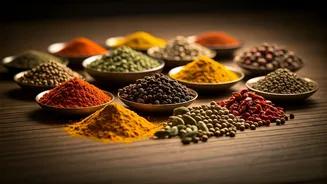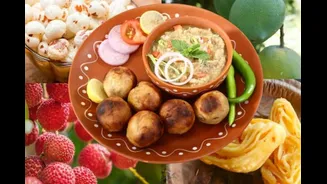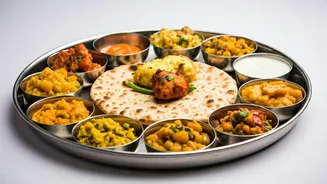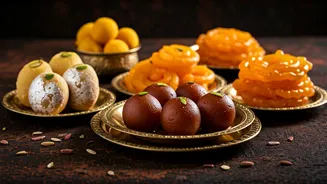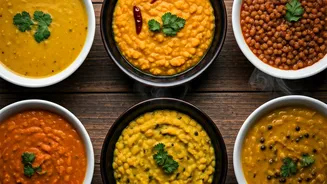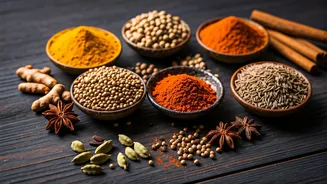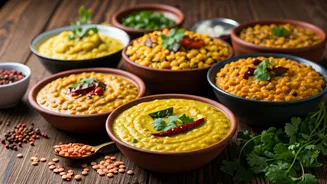A Culinary Introduction
Indian cuisine is a delightful blend of flavors, aromas, and textures, reflecting the country's vast cultural diversity. Each region offers a unique culinary
experience, influenced by local ingredients, climate, and traditions. The use of spices is fundamental, providing depth and complexity to dishes. Common ingredients include rice, wheat, lentils, vegetables, and various meats. Cooking methods vary from simple stir-fries to elaborate slow-cooked stews, demonstrating the versatility of Indian cooking. Popular dishes like butter chicken, biryani, and dosa have become global favorites, while regional specialties offer unique tastes. Understanding this diversity is key to appreciating Indian food's depth and breadth. The history of Indian cuisine is intertwined with trade routes, invasions, and cultural exchanges, each leaving its mark on the evolving culinary landscape. The fusion of flavors and techniques has created a cuisine that is both satisfying and captivating, continually enchanting food enthusiasts worldwide.
Spices and Aromatics
Spices are the heart and soul of Indian cuisine, contributing to its distinctive flavors and aromas. The skillful use of spices is a hallmark of Indian cooking, with each spice playing a crucial role. Common spices include turmeric, cumin, coriander, cardamom, cloves, and chilies. Turmeric, known for its vibrant color and medicinal properties, is a staple. Cumin and coriander add warmth and earthiness, while cardamom and cloves provide aromatic complexity. Chilies offer varying levels of heat, from mild to fiery. Spices are often used in combination, creating complex spice blends or masalas. The preparation of these masalas is a culinary art, with family recipes passed down through generations. Some dishes rely heavily on fresh herbs like cilantro and mint. The combination of spices and herbs creates a symphony of flavors that is both comforting and exhilarating, making Indian food unique. The balance of flavors is crucial, with sweet, sour, salty, and spicy elements working in harmony to create a truly memorable meal.
Regional Delights
India's diverse geography and cultures have led to an equally diverse range of regional cuisines. North Indian food often features rich, creamy curries, tandoori dishes, and flatbreads like naan and roti. Butter chicken and various vegetable curries are incredibly popular. South Indian cuisine is known for its use of rice, lentils, and coconut, and often has a lighter, more refreshing feel. Dishes like dosa, idli, and sambar are breakfast staples, and seafood plays a major role along the coasts. East Indian cuisine embraces the flavors of Bengal, with its focus on fish, rice, and delicate spice blends. The influence of Chinese and other Southeast Asian flavors is also evident. West Indian cuisine reflects the spice trade, offering dishes with bold, aromatic flavors. The Gujarati cuisine emphasizes vegetarian dishes, and the Goan cuisine often highlights seafood. Each region showcases a unique culinary heritage, making Indian food a treasure trove of culinary experiences. Exploring these regional variations offers a deeper understanding of India's culture and traditions.
Iconic Dishes Explored
Several Indian dishes have gained international recognition, becoming synonymous with Indian cuisine. Butter chicken, with its creamy tomato-based sauce and tender chicken, is a global favorite. Biryani, a flavorful rice dish with meat or vegetables, is a festive staple. Various types of biryani exist across the country, each with its unique flavor profile. Samosas, crispy fried or baked pastries filled with spiced potatoes and peas, are popular snacks. Dosa, a thin crepe made from fermented rice and lentil batter, is a South Indian breakfast dish often served with sambar and chutney. Tandoori chicken, marinated in yogurt and spices, is cooked in a tandoor oven, giving it a smoky flavor. The diversity of these iconic dishes reflects the broad range of culinary influences and regional specialties within India. These dishes provide a delicious entry point for anyone interested in exploring the world of Indian cuisine. They are often enjoyed at celebrations and family gatherings, representing the heart of Indian culture.
Cooking Techniques Unveiled
Indian cooking employs a range of techniques that enhance flavors and create diverse textures. Tandoori cooking, using a cylindrical clay oven called a tandoor, imparts a smoky flavor to meats and breads. Grilling is used extensively to prepare kebabs and other delicacies. Frying is a common technique used for making snacks like samosas and pakoras. Stir-frying is common, especially in dishes from the northern part of the country, using a wok for quick and flavorful meals. Slow cooking is also integral, with curries simmered for hours to develop rich flavors. Seasoning is a central aspect of these methods, adding depth and complexity. These techniques have been passed through generations, and are key to the distinctive taste. From simple everyday cooking to elaborate feasts, these methods exemplify the versatility and rich tradition. The combination of ingredients and methods gives rise to a wide variety of meals, catering to all tastes.
